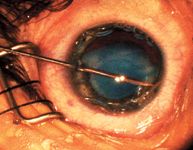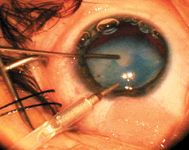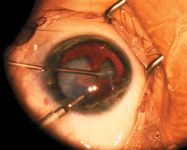Article
Use of 25-gauge instrumentation shows value in managing traumatic cataract in pediatric cases
Twenty-gauge vitrectomy has been the standard management technique for pediatric cataract for many years. Recent success with 25-gauge instruments, however, opens the door for ophthalmologists to have confidence when handling complex anterior segment surgeries in children.

Key Points

Dr. Airiani, a postdoctoral residency fellow at the Edward S. Harkness Eye Institute, Columbia University, New York, credited the guidance of her attending surgeon, Steven A. Kane, MD, PhD, associate clinical professor of ophthalmology at the institute, when she spoke here at the American Society of Cataract and Refractive Surgery annual meeting.
In the past two decades, 20-gauge vitrectomy has been the standard management for pediatric cataract. Recently, however, good success has been reported with 25-gauge instruments for complex anterior segment surgery in children, such as managing congenital cataract, posterior capsular opacification, secondary pupillary membrane, and release of vitreous incarceration in surgical wounds, according to Dr. Airiani.

In this case, a 5-year-old boy was hit in the left eye with a stone and developed a dense white cataract with irregular pupil. Dr. Airiani saw the boy 3 weeks after the injury.
Preoperative best-corrected acuity (BCVA) of the injured left eye was 20/200; it was 20/20 in the unaffected eye. IOP was symmetric and normal in both eyes. The left conjunctiva was clear. Iris sphincter tears were found at the 3 o'clock and 7 o'clock positions in the left eye. There was a linear rupture of the anterior capsule with surrounding capsule fibrosis accompanied by posterior synechiae from the 9 o'clock to 1 o'clock positions.
The lens epithelium was white and opaque except for a clear peripheral crescent that falsely suggested superior nasal lens dislocation. Peripheral anterior synechiae were noted from 4 to 7 o'clock, and angle recession was noted from the 7 to 12 o'clock positions during Koeppe gonioscopy just prior to the surgery.

"With three paracentesis incisions available, I could switch from one side to the other to facilitate synechiolysis," Dr. Airiani said.
She cleared the posterior synechiae in this patient using the 23-gauge microvitreoretinal blade and viscodissection through a 30-gauge cannula. She noted that 25-gauge scissors also can be useful to dissect more tenacious adhesions. "At the end, I did the viscodissection to ensure release of the adhesions," she said.
Initially, Dr. Airiani sought to create a continuous curvilinear capsulotomy in this patient's anterior capsule. Because of the partial fibrosis of the lens capsule, however, there were variable capsular thicknesses in different quadrants, making a continuous capsulotomy difficult.





